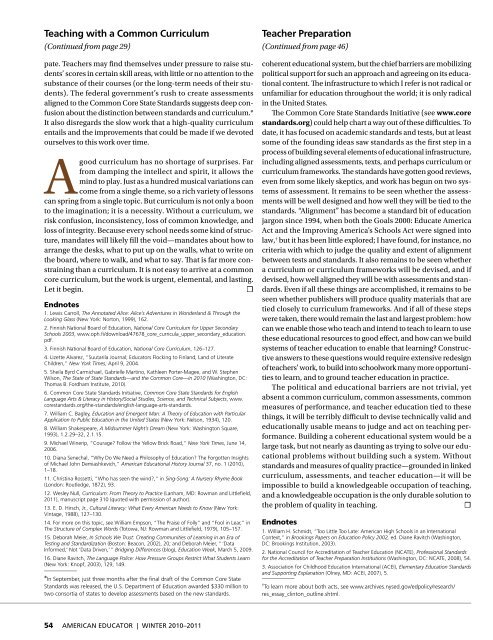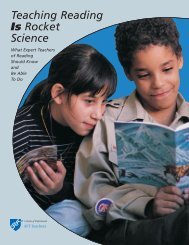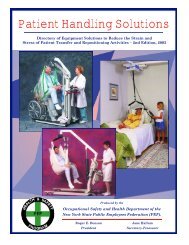American Educator, Winter 2010-11, Vol. 34, No. 4, AFT
American Educator, Winter 2010-11, Vol. 34, No. 4, AFT
American Educator, Winter 2010-11, Vol. 34, No. 4, AFT
You also want an ePaper? Increase the reach of your titles
YUMPU automatically turns print PDFs into web optimized ePapers that Google loves.
Teaching with a Common Curriculum<br />
(Continued from page 29)<br />
pate. Teachers may find themselves under pressure to raise students’<br />
scores in certain skill areas, with little or no attention to the<br />
substance of their courses (or the long-term needs of their students).<br />
The federal government’s rush to create assessments<br />
aligned to the Common Core State Standards suggests deep confusion<br />
about the distinction between standards and curriculum.*<br />
It also disregards the slow work that a high-quality curriculum<br />
entails and the improvements that could be made if we devoted<br />
ourselves to this work over time.<br />
A<br />
good curriculum has no shortage of surprises. Far<br />
from damping the intellect and spirit, it allows the<br />
mind to play. Just as a hundred musical variations can<br />
come from a single theme, so a rich variety of lessons<br />
can spring from a single topic. But curriculum is not only a boon<br />
to the imagination; it is a necessity. Without a curriculum, we<br />
risk confusion, inconsistency, loss of common knowledge, and<br />
loss of integrity. Because every school needs some kind of structure,<br />
mandates will likely fill the void—mandates about how to<br />
arrange the desks, what to put up on the walls, what to write on<br />
the board, where to walk, and what to say. That is far more constraining<br />
than a curriculum. It is not easy to arrive at a common<br />
core curriculum, but the work is urgent, elemental, and lasting.<br />
Let it begin. ☐<br />
Endnotes<br />
1. Lewis Carroll, The Annotated Alice: Alice’s Adventures in Wonderland & Through the<br />
Looking Glass (New York: <strong>No</strong>rton, 1999), 162.<br />
2. Finnish National Board of Education, National Core Curriculum for Upper Secondary<br />
Schools 2003, www.oph.fi/download/47678_core_curricula_upper_secondary_education.<br />
pdf.<br />
3. Finnish National Board of Education, National Core Curriculum, 126–127.<br />
4. Lizette Alvarez, “Suutarila Journal; <strong>Educator</strong>s Flocking to Finland, Land of Literate<br />
Children,” New York Times, April 9, 2004.<br />
5. Sheila Byrd Carmichael, Gabrielle Martino, Kathleen Porter-Magee, and W. Stephen<br />
Wilson, The State of State Standards—and the Common Core—in <strong>2010</strong> (Washington, DC:<br />
Thomas B. Fordham Institute, <strong>2010</strong>).<br />
6. Common Core State Standards Initiative, Common Core State Standards for English<br />
Language Arts & Literacy in History/Social Studies, Science, and Technical Subjects, www.<br />
corestandards.org/the-standards/english-language-arts-standards.<br />
7. William C. Bagley, Education and Emergent Man: A Theory of Education with Particular<br />
Application to Public Education in the United States (New York: Nelson, 19<strong>34</strong>), 120.<br />
8. William Shakespeare, A Midsummer Night’s Dream (New York: Washington Square,<br />
1993), 1.2.29–32, 2.1.15.<br />
9. Michael Winerip, “Courage? Follow the Yellow Brick Road,” New York Times, June 14,<br />
2006.<br />
10. Diana Senechal, “Why Do We Need a Philosophy of Education? The Forgotten Insights<br />
of Michael John Demiashkevich,” <strong>American</strong> Educational History Journal 37, no. 1 (<strong>2010</strong>),<br />
1–18.<br />
<strong>11</strong>. Christina Rossetti, “Who has seen the wind?,” in Sing-Song: A Nursery Rhyme Book<br />
(London: Routledge, 1872), 93.<br />
12. Wesley Null, Curriculum: From Theory to Practice (Lanham, MD: Rowman and Littlefield,<br />
20<strong>11</strong>), manuscript page 310 (quoted with permission of author).<br />
13. E. D. Hirsch, Jr., Cultural Literacy: What Every <strong>American</strong> Needs to Know (New York:<br />
Vintage, 1988), 127–130.<br />
14. For more on this topic, see William Empson, “The Praise of Folly” and “Fool in Lear,” in<br />
The Structure of Complex Words (Totowa, NJ: Rowman and Littlefield, 1979), 105–157.<br />
15. Deborah Meier, In Schools We Trust: Creating Communities of Learning in an Era of<br />
Testing and Standardization (Boston: Beacon, 2002), 20; and Deborah Meier, “ ‘Data<br />
Informed,’ <strong>No</strong>t ‘Data Driven,’ ” Bridging Differences (blog), Education Week, March 5, 2009.<br />
16. Diane Ravitch, The Language Police: How Pressure Groups Restrict What Students Learn<br />
(New York: Knopf, 2003), 129, 149.<br />
*In September, just three months after the final draft of the Common Core State<br />
Standards was released, the U.S. Department of Education awarded $330 million to<br />
two consortia of states to develop assessments based on the new standards.<br />
54 AMERICAN EDUCATOR | WINTER <strong>2010</strong>–20<strong>11</strong><br />
Teacher Preparation<br />
(Continued from page 46)<br />
coherent educational system, but the chief barriers are mobilizing<br />
political support for such an approach and agreeing on its educational<br />
content. The infrastructure to which I refer is not radical or<br />
unfamiliar for education throughout the world; it is only radical<br />
in the United States.<br />
The Common Core State Standards Initiative (see www.core<br />
standards.org) could help chart a way out of these difficulties. To<br />
date, it has focused on academic standards and tests, but at least<br />
some of the founding ideas saw standards as the first step in a<br />
process of building several elements of educational infrastructure,<br />
including aligned assessments, texts, and perhaps curriculum or<br />
curriculum frameworks. The standards have gotten good reviews,<br />
even from some likely skeptics, and work has begun on two systems<br />
of assessment. It remains to be seen whether the assessments<br />
will be well designed and how well they will be tied to the<br />
standards. “Alignment” has become a standard bit of education<br />
jargon since 1994, when both the Goals 2000: Educate America<br />
Act and the Improving America’s Schools Act were signed into<br />
law, † but it has been little explored; I have found, for instance, no<br />
criteria with which to judge the quality and extent of alignment<br />
between tests and standards. It also remains to be seen whether<br />
a curriculum or curriculum frameworks will be devised, and if<br />
devised, how well aligned they will be with assessments and standards.<br />
Even if all these things are accomplished, it remains to be<br />
seen whether publishers will produce quality materials that are<br />
tied closely to curriculum frameworks. And if all of these steps<br />
were taken, there would remain the last and largest problem: how<br />
can we enable those who teach and intend to teach to learn to use<br />
these educational resources to good effect, and how can we build<br />
systems of teacher education to enable that learning? Constructive<br />
answers to these questions would require extensive redesign<br />
of teachers’ work, to build into schoolwork many more opportunities<br />
to learn, and to ground teacher education in practice.<br />
The political and educational barriers are not trivial, yet<br />
absent a common curriculum, common assessments, common<br />
measures of performance, and teacher education tied to these<br />
things, it will be terribly difficult to devise technically valid and<br />
educationally usable means to judge and act on teaching performance.<br />
Building a coherent educational system would be a<br />
large task, but not nearly as daunting as trying to solve our educational<br />
problems without building such a system. Without<br />
standards and measures of quality practice—grounded in linked<br />
curriculum, assessments, and teacher education—it will be<br />
impossible to build a knowledgeable occupation of teaching,<br />
and a knowledgeable occupation is the only durable solution to<br />
the problem of quality in teaching. ☐<br />
Endnotes<br />
1. William H. Schmidt, “Too Little Too Late: <strong>American</strong> High Schools in an International<br />
Context,” in Brookings Papers on Education Policy 2002, ed. Diane Ravitch (Washington,<br />
DC: Brookings Institution, 2003).<br />
2. National Council for Accreditation of Teacher Education (NCATE), Professional Standards<br />
for the Accreditation of Teacher Preparation Institutions (Washington, DC: NCATE, 2008), 54.<br />
3. Association for Childhood Education International (ACEI), Elementary Education Standards<br />
and Supporting Explanation (Olney, MD: ACEI, 2007), 5.<br />
†<br />
To learn more about both acts, see www.archives.nysed.gov/edpolicy/research/<br />
res_essay_clinton_outline.shtml.





